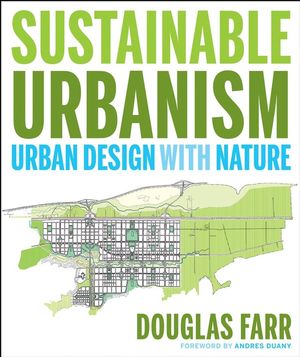Sustainable Urbanism: Urban Design With NatureISBN: 978-0-471-77751-9
Hardcover
352 pages
November 2007
 |
||||||
"Providing a historical perspective on the standards and regulations that got us and keep us on the course toward sprawl and unsustainable development, along with earlier attempts at reform, the book makes a strong case for Sustainable Urbanism, showing how architects and urban designers need to shape the built environment for the benefit of both humans and nature." (APADE, 2009)
"A masterpiece, it combines good writing with a thorough treatment of the subject." (The Bernard Place Bee Line, 4/22/08)
"It's not immediately obvious how Doug Farr's new book differs from the many other books in this field, aside from having a laudatory preface by Andres Duany. His careful division of the case studies into built greenfield, unbuilt greenfield, built infill, and unbuilt infill, should be a clue. It's also nice that he offiers a fairly specific definition of the s-word. Farr's book is distinguished by his systematic determination to reveal the trade secrets of sustainable design-those rules of thumb that bridge the gap between woolly generalities and highly specific case studies." (BuildingCommunities.com, February 1, 2008)
"A broadly-focused and solutions-based look at environmentally sustainable urban design. Case studies and essays written by Farr and others give a real-world context to the ideas and methods espoused in this ambitious argument on behalf of a new type urban design and development that is interrelated with nature." (Planetizen.com; 1/29/08)
"The author of Sustainable Urbanism wants to break down barriers between nature-focused environmentalists and human-focused urbanists. The book asserts that we need a radical change in how we live, not just for the health of our planet, but for ourselves. The author's ambitious goal is to make sustainable urbanism the dominant pattern of human settlement by 2030. This book is a valuable resource for anyone that is in a position to advance a more organic way of life that is more in tune with the environment." (Vector 1 Magazine, January 6, 2008)
"Sustainable Urbanism is important because it addresses the sustainable development issue from all sides and provides solutions across the vast array of disciplines that create the built environment. The book…should be a resource not just for developers...but also for city councils, mayors, governors, engineers, and voters." (Urban Land, 1/08)
"Beyond just developing a concept, however, the book acts as a comprehensive how-to manual for anyone who helps shape the environment...after setting the stage with a compelling case for sustainable urbanism, Farr provides specific and detailed standards and steps to guide readers." (Environmental News Network, 12/21/07)
"There is something for everyone in Sustainable Urbanism, the new book that tackles exactly what the title implies. Backed by an impressive range of research, tables, charts, it is a comprehensive look at how to make our development pattern more sustainable." (Joe Urban Blog, 12/07)
"Chicago architect Douglas Farr is no Le Corbusier--Who is?--yet his thoughtful new book is propelled by the same sort of visionary energy and desire to integrate architecture, city planning and nature for a better way of life. Here's the twist: Whereas Le Corbusier celebrated the car, Farr fingers it as a prime factor in creating today's sprawling, auto-dependent suburbs and all the lifestyle woes, like rising levels of obesity, they've supposedly wrought. While that's a familiar rant from the New Urbanist architects who call for compact, walkable communities, Farr wisely goes beyond them, urging a grand integration of the New Urbanism and the fledgling green building movement." (Chicago Tribune, December 2007)
"What makes his volume stand out is that it combines expertise in New Urbanism with a thorough understanding of environmental issues and techniques. The result is the most comprehensive, technically informed volume available on how to design and build places that are environmentally responsible and also gratifying to inhabit." (New Urban News, December 2007)
"makes excellent use of physical case studies, it is also concerned with the intangible forces that shape our cities…" (Building Design, Friday 15th February 2008)



